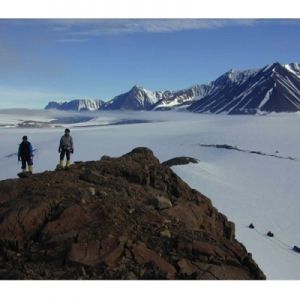
"We found two really unexpected results," said Duanne White, a geoscientist at the University of Canberra, who is part of a group of researchers using the new dating technique.
"Previously it had been thought that during the last Ice Age the Ice Sheet expanded all the way out to the continental shelf and was a thousand metres thicker at the margin. But we found quite the opposite - along the whole length of the Lambert Glacier, there was only a relatively small change.
"But the kicker for us was this happened very soon after global temperatures and sea level began to rise at the end of the last Ice Age. So while the response wasn't large at that particular time, it happened very quickly."
Uncertainty in sea level rise
The findings, published by the Australian Nuclear Science and Technology Organisation (ANSTO), are expected to contribute to updated sea level rise predictions in the next Intergovernmental Panel on Climate Change (IPCC) report.
A high degree of uncertainty has existed around the contribution of Antarctica to sea level rise. Some models have even predicted that the Ice Sheet will expand with climate change and offset some of the rise.
Comment: But if the ice sheet expands, how can they melt and therefore cause a rise in sea levels?
Thanks to mental gymnastics!
These scientists are missing the important fact here: it's not rising sea levels that we need to worry about; it's melting freshwater diluting salty seawater and interfering with ocean currents that keep much of the world warm.
"To give some perspective of the uncertainty involved in the previous [2007] IPCC report, it didn't include sea level rise from ice dynamics in Antarctica in its predictions," said White.
"I would expect the next report to have a lot more refined figures," he said. The next IPCC report is due within the next two years.
"A proxy for climate change"
Researched used a technique called cosmogenic surface exposure dating. As a glacier advances it breaks up rocks and boulders, called a moraine, which it leaves behind when it recedes as a result of climate change.
"So the moraine is a proxy for the change in climate," said David Fink, a nuclear physicist from ANSTO who led the research. "As soon as a glacier dumps the rocks that have been freshly churned up, they are exposed to cosmic rays. Then the clock starts."
Exposure dating works using similar principles to radiocarbon dating, "but kind of in reverse," said Fink. Beryllium-10 atoms accumulate in rocks exposed to cosmic rays at a rate of five atoms per gram each year. Researchers can then count the number of beryillium-10 atoms in dissolved rock samples using a sophisticated nuclear science technique called Accelerator Mass Spectrometry.
"Trying to measure a few thousand atoms in a gram of rock is like looking for a red millimetre stripe on a blue tape wrapped around the Earth's equator!" Fink said.
But by doing so, the researchers can calculate when the Ice Sheet retreated. Establishing the exposure ages of rocks from different elevations and locations, they can also estimate the volume of ice that filled the valley.
Evolution of the East Antarctic Ice Sheet
"Antarctica as you see today has been in existence for the past 30 million years, waxing and waning - but not extensively," said Fink. "But even a 10% change in the ice equates to metres of sea level rise, so it's critically important to know what is going to happen in the next few hundred years."
Comment: Forget the next few hundred years! If their satellite data is correct, the ENTIRE Greenland ice sheet melted this summer... we're looking at an ice age within a year or two.
Fink's research group studied the Lambert Glacier, which acts as a large drainage basin for the East Antarctic ice sheet. Using their results, along with data from other Antarctic locations collected by a handful of international groups, they plan to map the evolution of the Ice Sheet since the last Ice Age, 20,000 years ago.
"The East Antarctic Ice Sheet has been thought to be a 'sleeping giant', but it is increasingly a focus of attention as science poses questions of how it might be 'awakened'," said Tas van Ommen, leader of the Climate Processes and Change program at the Australian Antarctic Division, who wasn't part of the study.
"The exposure age dating of rock outcrops in the East Antarctic is a valuable additional tool to bring to bear on our understanding," he said.



Hackers are invading. Somehow they manage to insert their mad opinions (highlighted in blue) into the main body of the articles instead of in the comments section at the bottom of the page. Can the site admin look after this?